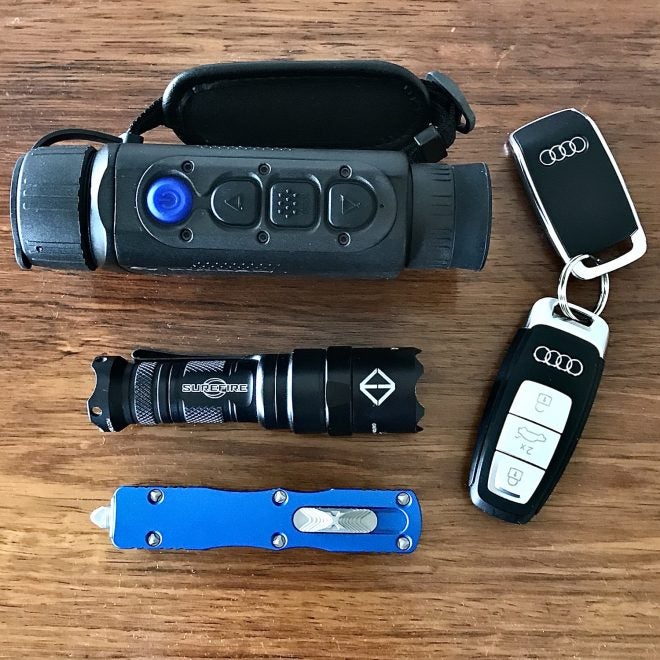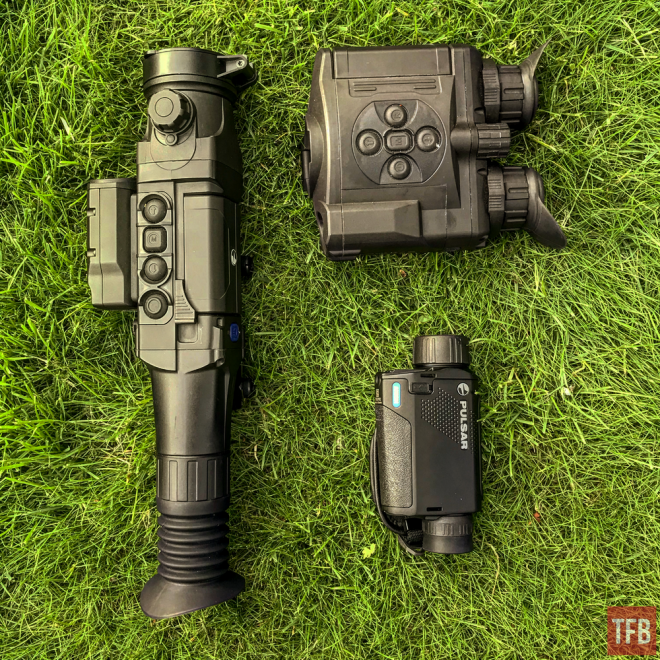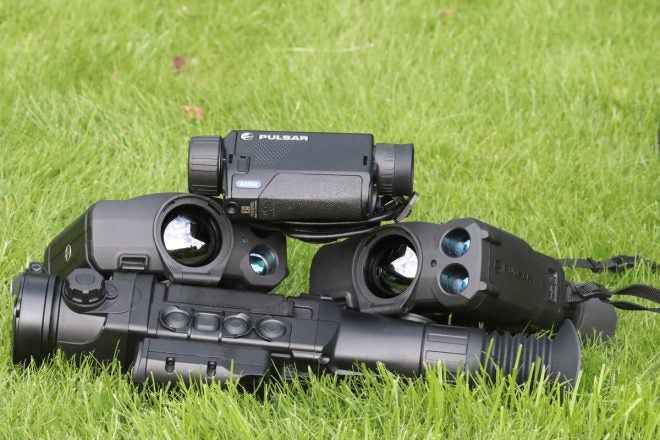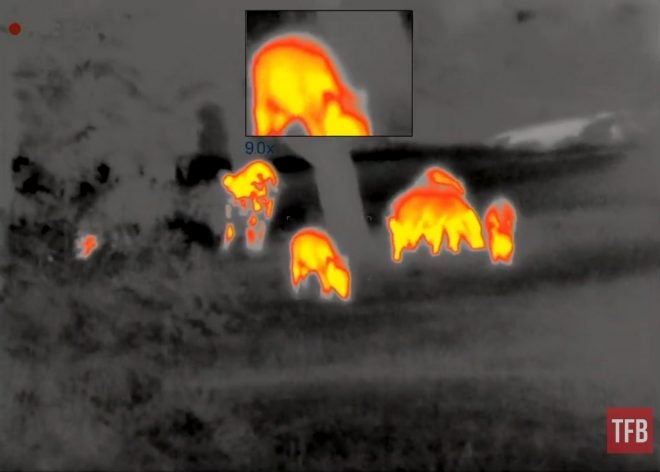Thermal spotters have many uses, anything from hunting to finding missing persons. They can greatly improve your hunting efficiency, as you can scan a part of the forest or a section of a field and quickly detect what’s out there. In fact, they work both day and night.
A thermal spotter cannot be used as a sight, so if you’re hunting you need to evaluate your options on what kind of optics to put on your rifle. The choice will depend on many things from national or local hunting legislation to your preference between traditional optics, a thermal sight or a night vision riflescope. Not to mention the size of your wallet.
Below: Is that a fire on the horizon, or just the sun setting? Where are the animals hiding? The Axion XM30S starts within 3 seconds after pressing the start button and will let you know.

Many professional hunters use a thermal scanner to quickly detect their target, then use digital night vision technology to positively identify the target and take the shot.
In this review, we will take a look at one of the smallest thermal devices out there – the new Pulsar Axion XM30S. I’ve had the device for almost three months and it’s been a nice companion during this summer.

You could EDC you Pulsar Axion XM30S without a problem. The watch is from Lum-Tec.
Ergonomics
The new Axion looks like a pocket video camera, which it is, in fact. It just records things that are not on our visible spectrum of light. The Axion XM30S is small, light and it gives a very robust feeling. The main housing is made of lightweight magnesium with some rubber over-molded for your palm.

Actually, you don’t need a flashlight if you can see in the dark.
The ocular and the lens are protected by polymer and rubber material. The lens cap is connected to the hand strap and has a magnet that attaches to the outside of the strap when you’re using the device. Pretty clever. There are four rubber buttons on the top of the XM30S, and the tactile feel works fine but is not perfect. The grip is comfortable, but if you have really large hands, you may have a slight over-reach to touch the buttons.
Being pocket-sized, it’s like bringing an extra smartphone with you. You can actually keep it in the front pocket of your jeans, although I wouldn’t recommend it. The weight is just 250 grams or 8.8 ounces. Overall, I would say that the device looks exclusive. The selection of materials is nice and the combination of surface finishes and colors (black, blue and silver) works great.
IMAGE QUALITY
The sensor at the front is 320×240 pix. 12 µm. The image quality is not as good as with some of the other units I’ve tried from Pulsar. For instance, the Pulsar Accolade 2 LRF and the Trail 2 LRF are much bigger and more powerful units. That doesn’t mean the new Axion is bad or useless. For the size, it’s probably among the top performers on the market.

This gives you a comparison between the Pulsar Trail 2 LRF XP50 riflescope, the Pulsar Accolade 2 LRF XP50 binoculars and the Axion XM30S.
The magnification goes from 4.5 to 18 and Pulsar claims that you can detect a standard 1.8 m (6 ft) tall object at 1300 meters (1420 yards) in complete darkness.
Personally, I use the low-end of the magnification range most if not all of the time, sometimes with the PiP (Picture in Picture) activated. The 4.5x minimum works, but the lower the better in my opinion. Again, to compare, the Accolade 2 has a magnification range between 2.5-20.

Pocket size, high-performance. Dry summer day, daylight, about 150 meters distance to the house.
I used the XM30S both in the forest and on open fields, and it was really easy and fast to spot wild game. I had many interesting encounters, and like I mentioned in a previous article, the thermal technology really brought me closer to Mother Nature.

PLEASE NOTE: All of the videos and still pictures are with the old firmware. Just at the end of this review Pulsar came out with the new 4.0 version which introduced a new User Mode, which is a new observation mode.
VIDEOS with the Axion XM30S
Here is a fox and a roebuck very close to each other in white hot (there are 8 color palettes to chose from). Even when the fox is moving faster and jumping, there’s no lag in the picture. Some of the expensive thermals I looked at a few years ago didn’t have this kind of performance.

Still picture of a fox, probably about 30-40 meters away. The fog is starting to come out on the grassy field. Pitch black outside.
And a roe deer with a fawn, with red hot.
European roe deer, fawn. Captured “red hot” with the new Pulsar Axion XM30S Thermal Spotter.
There’s also a video with a bunch of wild boars in the forest if you’re interested. One of them didn’t make it, and you can hear the shot around 1:52 into the video. The video doesn’t show it, but it was a perfect shot.

Wild boar. One didn’t make it.
Technical Specifications

The Axion in the palm of a hand.
Video Recording
At the press of the recording button, you have 16 Gb of built-in memory for either video or still photos. The resolution is 1024×768 pixels. You can see the result in the pictures and videos embedded in this article.
The unit has WiFi and with the Stream Vision App, you can download your recording, although I would recommend that you use the cable instead (I use a PC). Via the app, I also uploaded and updated to the latest firmware and had no issues.

Roe deer with company. Distance about 20 meters.
PRICE & AVAILABILITY
The price is around $1,900.00 (USA) and €1,690.00 (EU). The Axion XM30S is Made In Lithuania, and they seem to be available and in stock when I took a quick look at various online shops.
CONCLUSION
Is the Axion XM30S from Pulsar a pocket rocket? Yes, it certainly is. The best optic is always the one you have with you. Since this one is almost negligible in size and weight, it greatly improves the chances that you’ll bring it with you, even if you chose to travel really light. There are units that are more powerful, with better image quality, detection and identification specifications but the Axion is good enough for almost anything a hunter needs in a thermal scanner.
From a completely shut-off device, it only takes 3 seconds before you can use it, which increases your chances to actually record something that is about to happen. This start-up time is really impressive.
Thermal imagery needs a lot of energy, so depending on how you’re planning to use it you should consider buying one or even two spare batteries. They’re not very expensive. The operating time is about 4-5 hours.
I keep having some issues operating the menus in the software with my fingers, but it’s probably more due to myself rather than the device.
I am still wishing for a thermal unit to come out with an auto-focus, but it would probably add a lot to the size and cost. You do have to fiddle with the focus knob to keep the image sharp and crisp, especially on higher magnifications.

Pulsar Axion XQ38 LRF (left) and Axion XM30S (right). The latter is considerably smaller. Pen and Osborne automatic knife from Benchmade to illustrate the size.
If you have the need for a pocket-sized thermal spotter you should definitely take a look at the Axion XM30S. The biggest problem it had is when the new Pulsar Axion XQ38 LRF (Laser Range Finder) showed up on my doorstep. The Axion XQ38 without the LRF could be another option. They are a little bigger, a little heavier and they cost a little more but that would be my choice of the two.
We are committed to finding, researching, and recommending the best products. We earn commissions from purchases you make using the retail links in our product reviews. Learn more about how this works.
 Your Privacy Choices
Your Privacy Choices
